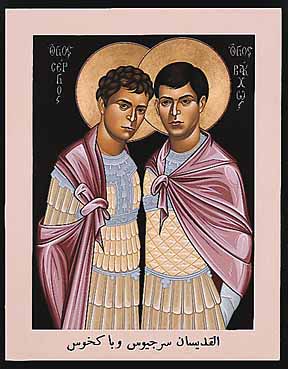Sergius & Bakkhus

(New Jersey USA)
the Moorish Orthodox Church of America.

E-MAIL: [email protected]
BISHOP MICHAEL FRANCIS AUGUSTINE ITKIN: CONFESSOR & PIONEER


The idea of an Old Catholic/Independent Orthodox ministry specifically to Queer folk was intorduced by Bishop George A. Hyde, presiding bishop of the Eucharistic Catholic Church, in around 1946. The first divine liturgy celebrated by that jurisdiction specifically for Queer folk took place on Christmas Eve of 1946, in the Cortton Blossom Room, a gay bar in Atlanta, Georgia, with 85 people in attendance. Hyde led the small group for many years, officially announcing its existence and mission in 1954, in "One" Magazine, the periodical of the Mattachine Society. That announcement attracted many followers, including one Michael Itkin, whom Bishop Hyde first licensed to ministry in 1955 and then ordained to the priesthood on May 6, 1957.
For the next two years through 1959, Father Michael worked as a priest in the Eucharistic Catholic Church, but in emphasizing the politically activist dimension of that minisitry split with Hyde in 1959, feeling that the bishop was backing away from an openly gay ministry and "moving back into the closet."
Father Itkin gathered the more politically and socially radical members of the Church together and led them in the capacity of episcopal administrator until November of 1960, when he was consecrated to the episcopate by Archbishop Christopher Maria Stanley, of blessed memory. Archbishop Stanley had received his own episcopal orders from no less than Hugh deWillmott-Newman, whose orders included (among others) a Syro-Chalderan lineage derived from Archbishop U.V. Herford, primate of England's Evangelical Catholic Communion established in 1902, following Bp Herford's own consecration by Mar Basilius of the Syro-Chaldena Church in India, Ceylon, Socotra & Messina.. Father Itkin chose that name for his new community, the first of several, which fact has regrettably contributed to this great man's obscurity and shadowy "demimonde" status in the ranks of Saints and spiritual teachers.
Father Itkin and his associates first called their group the Primitive Catholic Church (Evangelical Catholic), changed at its november 1960 Synod to the Gnostic Catholic Church (Evangelical Catholic), a name which gave rise to the ocnfusion that the Church espoused the Gnostic heresy. They thereafter adopted the name "Free Catholic" until it was learned that a British group of fascist political leaning also used that appellation. The Synod thereafter changed the name of the Church once again, this time to Western Orthodox Catholic (Anglican Orthodox).
During this period of time, the Synod learned of Bishop Vernon Herford and the Evangelical Catholic Communion which he led, and the Synod corresponded with some of Bishop Herford's European associates deriving their leave to reformulate the Evangelical Catholic Comunion in America. It was only a short time before Bishop Itkin and Archbishop Stanley parted ways, again, due in large part to the radical social activism advocated by Itkin. Also, in 1963, the Communion undertook an internal reorganization as a religious order originally caled the Brotherhood of the Love of Christ, later changed to the Community of the Love of Christ to eliminate the sexist connotation of the word Brotherhood.
During the 1960's the Evangelical Catholic Communion attracted support from the radical community and a number of extremely able leaders such as John Andrew Perry-Hooker, a psychologist working in Boston in the area of youth ministry (among others). It involved itself in many of the civil rights and anti-war efforts, Bishop articulated a theology of revolutionary Christianity based upon pacifism, freedom from oppression, and civil rights. He advocated Gay Liberation and Christianity as a means toward the establishment of an egalitarian, universal androgynous community, having much in common with the yet-to-be-born Liberation Theology.
Increasingly, Bishop Itkin became involved in issues of sexism and gender oppression and in the late 1960's became one of the first Old Catholic bishops to ordain women, a move that led to a major split in his jurisdiction and the loss of most of its property.
